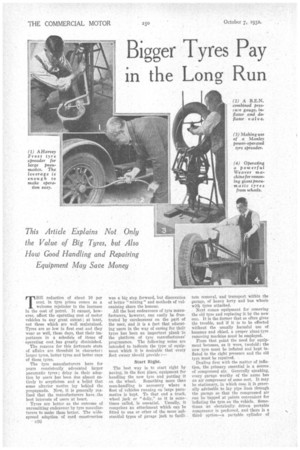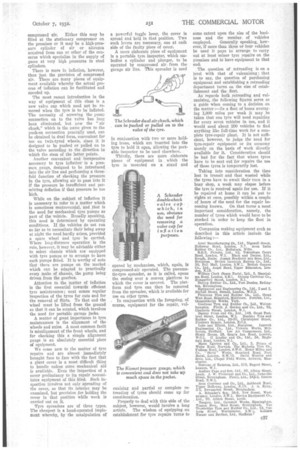Bigger Tyres Pay
Page 86

Page 87

If you've noticed an error in this article please click here to report it so we can fix it.
in the Long Run
This Article Explains Not Only the Value of Big Tyres, but Also How Good Handling and Repairing Equipment May Save Money
THE reduction of about 10 per cent. in tyre prices comes as a welcome rejoinder to the increase in the cost of petrol. It cannot, however, affect the operating cost of motor vehicles to any great extent ; at least, not those which are well maintained. Tyres are so low in first cost and they wear so well, these days, that their importance in a schedule of items of operating cost, has greatly diminished.
The reasons for this fortunate state of affairs are threefold in character : larger tyres, better tyres and better care of those tyres.
The tyre manufacturers have for years consistently advocated larger pneumatic tyres ; delay in their adoption by users has been due almost entirely to scepticism and a belief that some ulterior motive lay behind the propaganda. Now, it is generally realized that the manufacturers have .the best interests of users at heart.
Tyres are better as the outcome of unremitting endeavour by tyre manufacturers to make them better. The widespread adoption of cord construction
was a big step forward, but discoveries of better "mixing" and methods of vulcanizing share the honour.
All the best endeavours of tyre manufacturers, however, can easily be frustrated by carelessnesi on the part of the user, and it is a fact that educating users in the way of caning for their tyres has been an important plank in the platform of tyre manufacturers' programmes. The following notes are intended to indicate the type of equipment which it is desirable that every fleet owner should provide :
Start Right.
The best way is to start right by !laving, in the first Place; equipment for handling the new tyre and putting it
on the wheel. Something more than man-handling is necessary where a fleet of vehicles running on large pneumatics is kept. To that end a truck, wheel jack or " dolly," as it is some-_ times called, is essential. Usually, it comprises an attachment which can be fitted to one or other of the more substantial types of garage jack to facili
tate removal, and transport within the garage, of heavy lorry and bus wheels with tyres attached.
Next comes equipment for removing the old tyre and replacing it by the new one. It is the former that so often gives the trouble, and if it is to be effected without the usually harmful use of hammer and chisel, a proper giant-tyre removing machine must be employed.
From that point the need for equipment becomes, as it were, twofold : the new tyre must be inflated and 'kept inflated to the right pressure and the old tyre must be repaired. . Dealing first with the matter of inflation, the primary essential is a source of compressed air. Generally speaking, every garage worthy of the name has an air compressor of some sort. It may he stationary, in which case it is generally advisable to lay pipe lines through the garage so that the compressed air can be tapped at points convenient for inflating the tyre on the vehicle. Sometimes an electrically driven portable compressor is preferred, and there is a thirdoption—a portable cylinder of . compressed air. Either this may be filled at the stationary compressor on the premises or it may be a high-pressure cylinder of air or nitrogen acquired from one or other of the concerns which specialize in the supply of gases at very high pressures in steel cylinders.
There is more in inflation, however, than just the provision of compressed air. There are many pieces of equipment available whereby the actual process of inflation can be facilitated and speeded up.
The most recent introduction in the way of equipment of this class is a new valve cap which need not be removed when the tyre is to be inflated. The necessity of screwing the pump connection on to the valve has long been eliminated, but now the " air cluck," which is the name given to the push-on connection generally used, can be obtained in dual form, convenient for use on twin-tyred wheels, since it is designed to be pushed or pulled on to the valve according to the direction in which the stem of the latter poiuts.
Another convenient and inexpensive accessory to tyre inflationis a pressure gauge, designed to be introduced into the air line and performing a threefold function of checking the pressure in the tyre, allowing air to pass into it if the pressure be insufficient and permitting deflation if that pressure be too high.
While on the subject of inflation it is necessary to refer to A matter which is sometimes controversial, and that is the need for mechanical tyre pumps as part of the vehicle. Broadly speaking, this need is determined by operating eonditions. If the vehicles do not run so far as to necessitate their being away at night the need hardly arises, provided a spare wheel and tyre be carried. Where long-distance operation is the rule, however, it may be advisable either to select chassis which are equipped with tyre pumps or to arrange to have such pumps fitted. It is worthy of note that there are pumps on the market which can be adapted to practically every make of chassis, the pump being driven from the gearbox.
Attention to the matter of inflation is the first essential' towards efficient tyre maintenance ; next comes regular inspection of the tyres for cuts and for the removal of flints. To that end the wheel must be lifted from the ground so that it can be rotated, which involves the need for portable garage jacks.
A matter of great importance in tyre maintenance is the alignment of the wheels and axles. A most common fault is misalignment of the front wheels, and for checking this a simple alignment gauge is an absolutely essential piece of equipment.
We come now to the matter of tyre repairs and are almost immediately brought face to face with the fact that a giant cover is a most difficult thing to handle unless some mechanical aid is available. Even the inspection of a cover preliminary to its repair necessitates equipment of this kind. Such inspection involves not only spreading of the cover, so that its interior may be examined, but provision for holding the cover in that position while work is carried out on it.
Tyre spreaders are of three types. The cheapest is a hand-operated implement whereby, by the manipulation of a powerful toggle lever, the cover is spread and held in that position. Two such levers are necessary, one at each side of the faulty piece of cover.
A more elaborate piece of equipment is a portable tyre inspector, which embodies a cylinder and plunger, to be operated by compressed airfrom the garage air line. This spreader is 'used in conjunction with two or more holding irons, which are inserted into the tyre to hold it open, allowing the portable inspector to be used elsewhere.
Thirdly, there are more elaborate pieces of equipment in which the tyre is mounted on a stand and opened by mechanism, which, again, is compressed-air operated. The pneumatic-tyre spreader, as it is called, opens the easing over a convex platform to which the cover is secured. The platform and tyre can then be removed from the spreader, which is available for use on other tyres.
In conjunction with the foregoing, of course, equipment for the repair, vul canizing and partial or complete retreading of tyres should come up for consideration.
Properly to deal with this sd.de of the subject, however, would involve a long article. The wisdom of equipping an establishment for tyre repairs turns to some extent upon the size of the business and the number of vehicles
employed. Generally speaking, however, if more than three or four vehicles be used it pays to arrange to carry out at least minor tyre repairs on the premises and to have equipment to that end.
The question of retreading is on a level with that of vulcanizing ; that is to say, the question of purchasing equipment and establishing a retreading department turns on the size of establishment and the fleet.
As regards both retreading and vulcanizing,.the following figures serve as a guide when coming to a decision on the matter :—In a fleet of buses averaging 1,000 miles per week it may be taken that one tyre will need repairing for every seven vehicles in use, and it would need about 200 vehicles to find anything like full-time work for a cornplete• tyre-repair plant. It is not sufficient, however, to judge the need for tyre-repair equipment or its economy merely on the basis of work directly available for it. Consideration shoeld be had for the fact that where tyres have to be sent out' for repairs the use of those tyres. is temporarily lost.
Taking into consideration the time lost in transit arid that wasted while the tyres have to await their turnin a busy shop, a week. may elapse before the tyre is received again for use. If it be repaired at home it can be put to rights at once, possibly within a couple of hours of the need for the repair be-. coming known. On that turns a most. important consideration, namely, the number of tyres which would have to be stocked in order to keep the fleet in operation.
Companies making equipment such as described in this article include the following :—
Arrel Manufacturing Co., Ltd., Digswell Street, Holloway Road, Landon, N.7. Avon India Rubber Co., Ltd., Melkshara, Wilts. B.E.N. Patents, Ltd., 92, Tottenham Clourt Road, London, W.1. Black and Decker, Ltd., Slough, Bucks. Joseph Bradbury and Sons, Ltd., Braintree. British Goodrich Rubber Co., Ltd., 50, Pall Mall, London, SW.].. British Oxygen Co., Ltd., Angel Road. Upper Edmonton, London N.1.
N.18. • William Clark (Spare Parts), Ltd. 5, Marshalsea Road, London, &Ed. County Chemical Co., Hungerford Street, London, E.1. Dunlop Rubber Co.. Ltd., Fort Dunlop, Erdington, Birmingham.
Equipment and Engineering Co., LW., 2 and 3, Norfolk Street, Strand, London, W.C.2, Firestone Tyre and Rubber Co., Ltd., Great West Road, Brentford, Middlesex. Fortifex, Ltd., Clementherpe Works, York.
Goodyear Tyre and Rubber Co., Ltd., Wolverhampton. Fredk. J. Gordon and Co., LW., 92, Charlotte Street, London, W.1.
Harvey Frost and On., Ltd., 148, Great Port.' /and Street. London, W.1. Henleys Tyre and Rubber Co., Ltd., 20-22, Christopher Street, Finsbury Square, London, E.0.2. Lake and Elliott, Ltd., Braintree. Laycock Engineering Co., Ltd., Victoria Works, Millhouses, Sheffield. Imo Air Compressors, Ltd., Shield House, 28, Gray's Inn Road, London, W.(11. a Lindley and Co., Ltd., 34, Englefield Road, London, 11.1. 3fenn Egerton and Co., Ltd., 5, Prince of Wales Road, Norwich. The Michelin Tyro Co., Fulham Road, London, S.W.6. Henry Miller and Co., " Skyhi " Works, Standard Road, Park Royal, London, N.W.10. David Moseley and Sons, Ltd., Chapel Field Works, Ardwick, Manchester.
Newtons of Taunton, Ltd., 319, Regent Street, London, W.1.
Andrew Page and Son, Ltd., 99, Albion Street, Leeds. J. W. Pickavant and Co., Ltd., Granville Street, Birmingham. Pirelli, Ltd., 34.3-5, Euston Road, N.W.1.
Ross Courtney and Co.. Ltd., Ashbrook Road, Upper Holloway, London, N.19. J. A. Rylen 3-a, Newmarket Street, Birmingham.
A. Schrader's Son, 26-9, New 'Street, Westminster, London, S.W.1. Service Equipment Co., Ltd., 99, Albion Street, Leeds.
Tangyes, Ltd., Cornwall Works, Birmingham. Thnson Bros., Moor Street, Birmingham. Tar Tr.-A-abridge Tyre and Rubber Co., Ltd., 54. victoria Street, Westminster, S.W.i„. Wi.U.hun Turner and Brother, Ltd., Sheffield.l




































































































































































